
According to a new report, most U.S. homes have done away with their landline service, and now only use cell phones to stay connected. The report was released by the U.S. Department of Health and Human Services, and notes that a hefty 50.8 percent of U.S. households now only use cell phones.
Another 39.4 percent of households have both landlines and wireless phones, while just 6.5 percent of households only use landlines. Another 3.2 percent do not have a phone at all.
The report follows a survey of around 20,000 households, and it shows how much difference a decade can make. In 2007, only around 15 percent of U.S. households had a wireless phone.
The results were also broken down based on age. More than 70 percent of people between the ages of 25 and 34 use only a wireless phone, and households with children are more likely to do away with the landline than households with adults only. Another breakdown focused on whether or not the household was renting or owned the house — 71.5 percent of adults living in rented homes used only wireless phones, while 40.9 percent of adults in houses they owned used only wireless phones.
Income also made a significant difference. Adults who lived in poverty or near poverty were much more likely to use only wireless phones than adults who had a higher income.
It will certainly be interesting to see how these figures change over another decade. Will the landline be totally dead in 2027?
Check out the statistics for yourself here.



